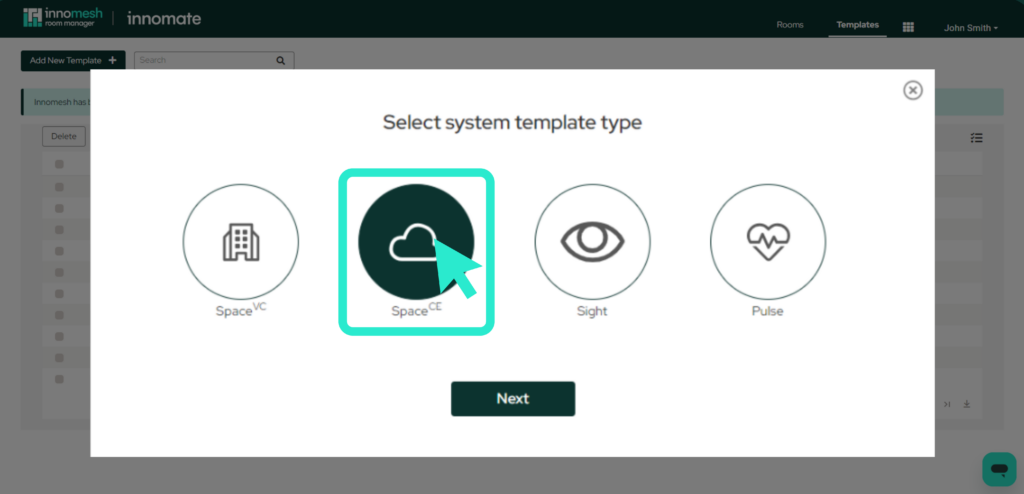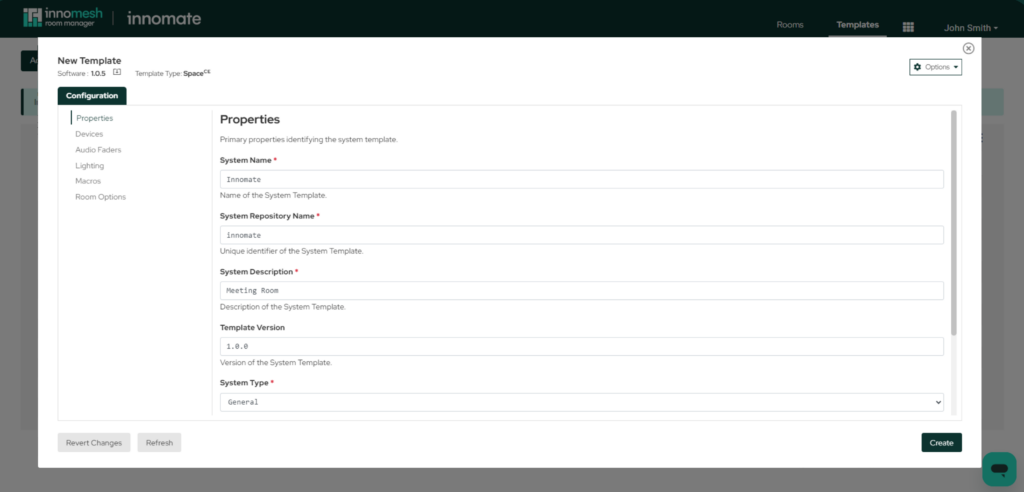Introduction
Within SpaceCE, a system template is a base configuration that forms the blueprint of a room. Unlike SpaceVC, SpaceCE system templates can be updated without affecting the rooms created from them.
Configuration Options for a SpaceCE Template
You may access Space CE Template by selecting it via the pop up window as shown below:

The configuration options available for your SpaceCE system template are dependent on the SpaceVC software you are using. However, all SpaceCE software share the below configuration options:
- Properties
- Devices
- Macros
- Room Options
The below section provides an overview of each of these configuration options.
Properties
The configuration options under “Properties” are general information related to a system template.

The following fields are available in this section:
System Name
The name of the system type represented by this system template configuration.
System Repository Name
This is auto-populated based on the System Name. This is the global identifier of the system template.
System Description
A description of the system type represented by this system template configuration.
Template Version
The version number of this template, to track changes over time. The version number must be in the format ‘major.minor.revision’. E.g. 1.0.0.
When system templates are updated, Innomesh offers the option to auto-increment this version.
System Type
The type of system this template configuration represents. This can be any of the following:
- General
- Boardroom
- Breakout Area
- Collaboration Space
- Conference Room
- Control Room
- Exhibition Hall
- Foyer
- Huddle Space
- Laboratory
- Lecture Theatre
- Meeting Room
- Office
- Signage
- Simulation Room
- Stadium
- Teaching Space
- Tutorial Room.
System Author
The author of this system template configuration. This is automatically populated with the name of the user creating the system template.
Is Portable
This marks rooms created with this system template as “portable”, i.e. it is expected that this room will not always be online as part of its normal operation. Marking a room as “portable” results in all alerts for the room automatically diverting to the “Suppressed Alerts” tab on the Portal Hotlist.
For more information, please refer to this link.
Devices
Main View

In the main device view we can see 5 primary sections.
A. Control
Devices are separated into 2 categories, selectable on the centre column:
- IP – these are devices that are controlled over the network
- Gateway – these are devices that are controlled via another device, and may be abstract. E.g. a lighting fader.
Pulse (Monitoring) can be included in this template.
B. Device Fields
Fields which describe the key properties of a device, such as the device name, the name of the driver used to control the device, the device IP address, etc.
C. Duplicate, Edit and Delete
These allow a device to be duplicated, edited and deleted.
The “Edit” button takes users to a detailed view of the device, allowing for further customisation of the device if required.
D. Download as CSV File
This button download the list of devices in this category as a CSV file.
E. Add New Device
This button allows the user to add a new device of the selected category.
“Add New Device” View
When adding a new device, the following fields are presented.

A. Is Portable, PDU Connected & Disable
Is Portable
If checked, alerts from this device will be diverted to the “Suppressed” alerts list on the Innomesh Portal Hotlist. This featured can be used if the device is portable and is not always connected i.e. a display on a removable trolley.
PDU Connected
This denotes that the device is connected to a power distribution unit (PDU), and only turns on while the room is powered on. If checked, alerts from this device be diverted to the “Suppressed” alerts list on the Innomesh Portal Hotlist while the room is powered off.
Disable
If this button is checked, the device will be disabled from the configuration.
B. Standard Fields
These are fields which describe the key components of a device.
Depending on the type of device being created, these fields will be different. Fields that are common to all types of device are:
- Type
- Driver
- Name
- ID
- Model
This will be discussed in greater detail below.
C. Advanced Connection Settings
This is an expandable menu which shows advanced connection settings relevant for this device type. It is hidden by default.
D. Cancel
This discards all changes made to this device configuration and returns you to the Device main page.
E. Add Device
Once all of the required fields are input, this adds the device to the template configuration.
Common Elements to all Device Types
Each device type has different fields which the user must fill out.

ID
The unique identifier for the device. This is automatically populated depending on the device type selected.
Name
The friendly name for the device.
Driver
The driver which SpaceCE uses to connect to and control the device.
IP Devices
- Type – The device type. E.g. Camera or Projector.
- Driver – The driver which SpaceCE uses to control the device.
- Name – The ‘friendly name’ for the device.
- ID – The auto-generated unique identifier for the device. For e.g. dev.display.1.
- Model – The Model of the device.
Advanced Settings
- IP Port – The IP port for connecting to the device, if different from the device default.
- Username – The username required (if any) to connect to the device.
- Password – The password required (if any) to connect to the device.
Gateway Devices

- Type – The device type. E.g. Audio Fader.
- Driver – The driver which SpaceCE uses to connect to and control the device.
- Name – The ‘friendly name’ for the device.
- ID – The auto-generated unique identifier for the device. For e.g. dev.display.1.
- Gateway Device ID – The ID of the device through which this device communicates.
Macros
This section contains the definitions for macros.
Macros are custom actions, definable as a script, that are set off by a “trigger”. Triggers can either be based on an event (e.g. when the system powers on), or on a time, and optionally, on particularly days of the week.

The definition for macros consists of the following elements:
ID
The unique identifier for the macro. It is recommended that this be defined in the following format: macro.trigger.[device].operation. For e.g. macro.poweron.1.
Disable
If set to true, this macro is ignored in the configuration.
Name
The friendly name for the device.
Triggers / Time Triggers
This array element defines the one or more time-based triggers that set this macro. The array consists of the following elements:
ID
The unique identifier for this trigger.
Disable
If set to true, this trigger is ignored in the configuration.
Time
The 24-hour time, in the format HH:mm:ss, at which the macro is to trigger. This is relevant for “Time” triggers only.
Days
A comma separated list of days of the week on which the macro is to trigger. Also This is relevant for “Time” triggers only.
Example values are:
“Monday, Tuesday, Thursday”.
“Weekday” (Monday to Friday)
“Weekend” (Saturday or Sunday)
Triggers / Event Triggers
This array element defines the one or more event-based triggers that set this macro. The array consists of the following elements:
ID
The unique identifier for this trigger.
Disable
If set to true, this trigger is ignored in the configuration.
Guid
The GUID of the object generating the event. Relevant for Event trigger types only.
Property
The object property this event relates to. Relevant for Event trigger types only.
Key
For Dictionary object properties, the key by which the property value is accessed. Relevant for Event trigger types only.
Index
For List object properties, the index by which the property value is accessed. Relevant for Event trigger types only.
Value
The property value which, if matched, triggers this macro. Relevant for Event trigger types only.
Actions
This array element defines the one or more actions that are set off when the trigger conditions are met. The array consists of the following elements:
ID
The unique identifier for this action.
Disable
If set to true, this trigger is ignored in the configuration.
Script
The script that defines the action.
Device ID
This is required when the device keyword is used within the lambda script, to specify the ID of the device it is to refer to. Device IDs are defined under #/Devices/IP/ID.
Delay
The delay, in seconds, between the macro trigger occurring, and the macro action being executed.
Room Options
“Room Options” is where you define the things from the list that you would like to manage at the room level. You can do that by checking items from the list. When managing the rooms users will only be able to see what you select here.
For more options about user permissions, please see this article here.

